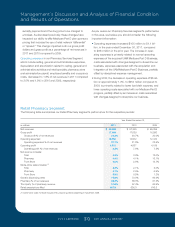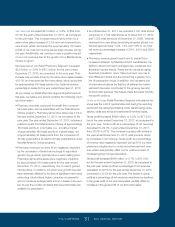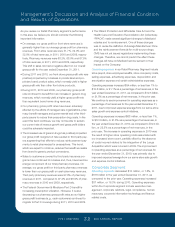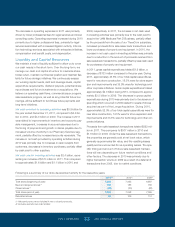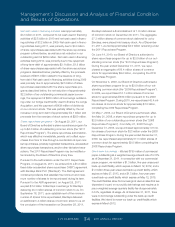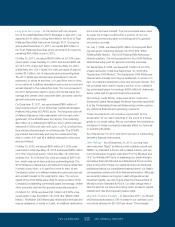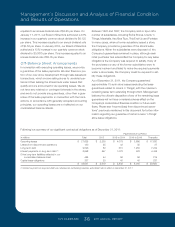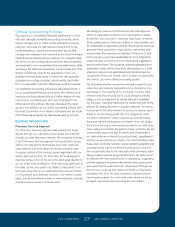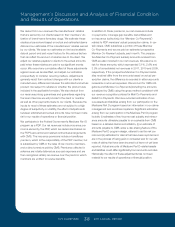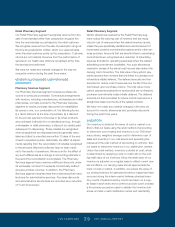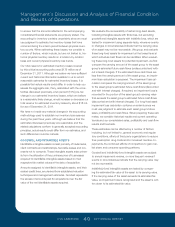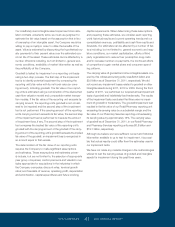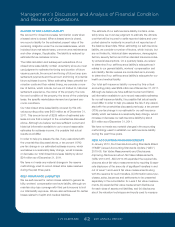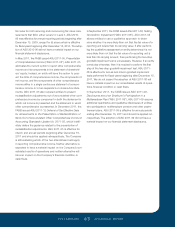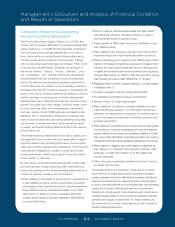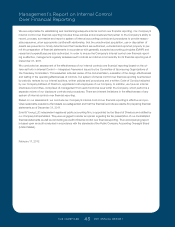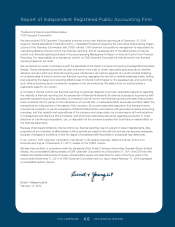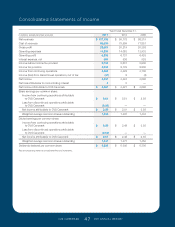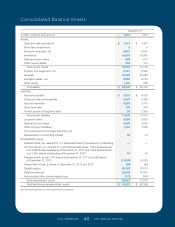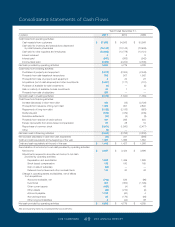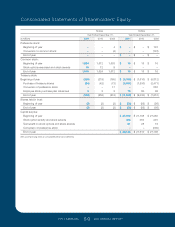CVS 2011 Annual Report Download - page 42
Download and view the complete annual report
Please find page 42 of the 2011 CVS annual report below. You can navigate through the pages in the report by either clicking on the pages listed below, or by using the keyword search tool below to find specific information within the annual report.
Management’s Discussion and Analysis of Financial Condition
and Results of Operations
CVS CAREMARK 40 2011 ANNUAL REPORT
to ensure that the amounts reflected in the accompanying
consolidated financial statements are properly stated. The
accounting for inventory contains uncertainty since we must
use judgment to estimate the inventory losses that have
occurred during the interim period between physical inven-
tory counts. When estimating these losses, we consider a
number of factors, which include, but are not limited to, his-
torical physical inventory results on a location-by-location
basis and current physical inventory loss trends.
Our total reserve for estimated inventory losses covered
by this critical accounting policy was $179 million as of
December 31, 2011. Although we believe we have sufficient
current and historical information available to us to record
reasonable estimates for estimated inventory losses, it is
possible that actual results could differ. In order to help you
assess the aggregate risk, if any, associated with the uncer-
tainties discussed previously, a ten percent (10%) pre-tax
change in our estimated inventory losses, which we believe
is a reasonably likely change, would increase or decrease our
total reserve for estimated inventory losses by about $18 mil-
lion as of December 31, 2011.
We have not made any material changes in the accounting
methodology used to establish our inventory loss reserves
during the past three years. Although we believe that the
estimates discussed previously are reasonable and the
related calculations conform to generally accepted accounting
principles, actual results could differ from our estimates, and
such differences could be material.
GOODWILL AND INTANGIBLE ASSETS
Identifiable intangible assets consist primarily of trademarks,
client contracts and relationships, favorable leases and cov-
enants not to compete. These intangible assets arise primar-
ily from the allocation of the purchase price of businesses
acquired to identifiable intangible assets based on their
respective fair market values at the date of acquisition.
Amounts assigned to identifiable intangible assets, and their
related useful lives, are derived from established valuation
techniques and management estimates. Goodwill represents
the excess of amounts paid for acquisitions over the fair
value of the net identifiable assets acquired.
We evaluate the recoverability of certain long-lived assets,
including intangible assets with finite lives, but excluding
goodwill and intangible assets with indefinite lives, which are
tested for impairment using separate tests, whenever events
or changes in circumstances indicate that the carrying value
of an asset may not be recoverable. We group and evaluate
these long-lived assets for impairment at the lowest level at
which individual cash flows can be identified. When evaluat-
ing these long-lived assets for potential impairment, we first
compare the carrying amount of the asset group to the asset
group’s estimated future cash flows (undiscounted and with-
out interest charges). If the estimated future cash flows are
less than the carrying amount of the asset group, an impair-
ment loss calculation is prepared. The impairment loss cal-
culation compares the carrying amount of the asset group
to the asset group’s estimated future cash flows (discounted
and with interest charges). If required, an impairment loss is
recorded for the portion of the asset group’s carrying value
that exceeds the asset group’s estimated future cash flows
(discounted and with interest charges). Our long-lived asset
impairment loss calculation contains uncertainty since we
must use judgment to estimate each asset group’s future
sales, profitability and cash flows. When preparing these esti-
mates, we consider historical results and current operating
trends and our consolidated sales, profitability and cash flow
results and forecasts.
These estimates can be affected by a number of factors
including, but not limited to, general economic and regula-
tory conditions, efforts of third party organizations to reduce
their prescription drug costs and/or increased member co-
payments, the continued efforts of competitors to gain mar-
ket share and consumer spending patterns.
Goodwill and indefinitely-lived intangible assets are subject
to annual impairment reviews, or more frequent reviews if
events or circumstances indicate that the carrying value may
not be recoverable.
Indefinitely-lived intangible assets are tested by compar-
ing the estimated fair value of the asset to its carrying value.
If the carrying value of the asset exceeds its estimated fair
value, an impairment loss is recognized and the asset is writ-
ten down to its estimated fair value.
127087_Financial.indd 40 3/9/12 9:42 PM


